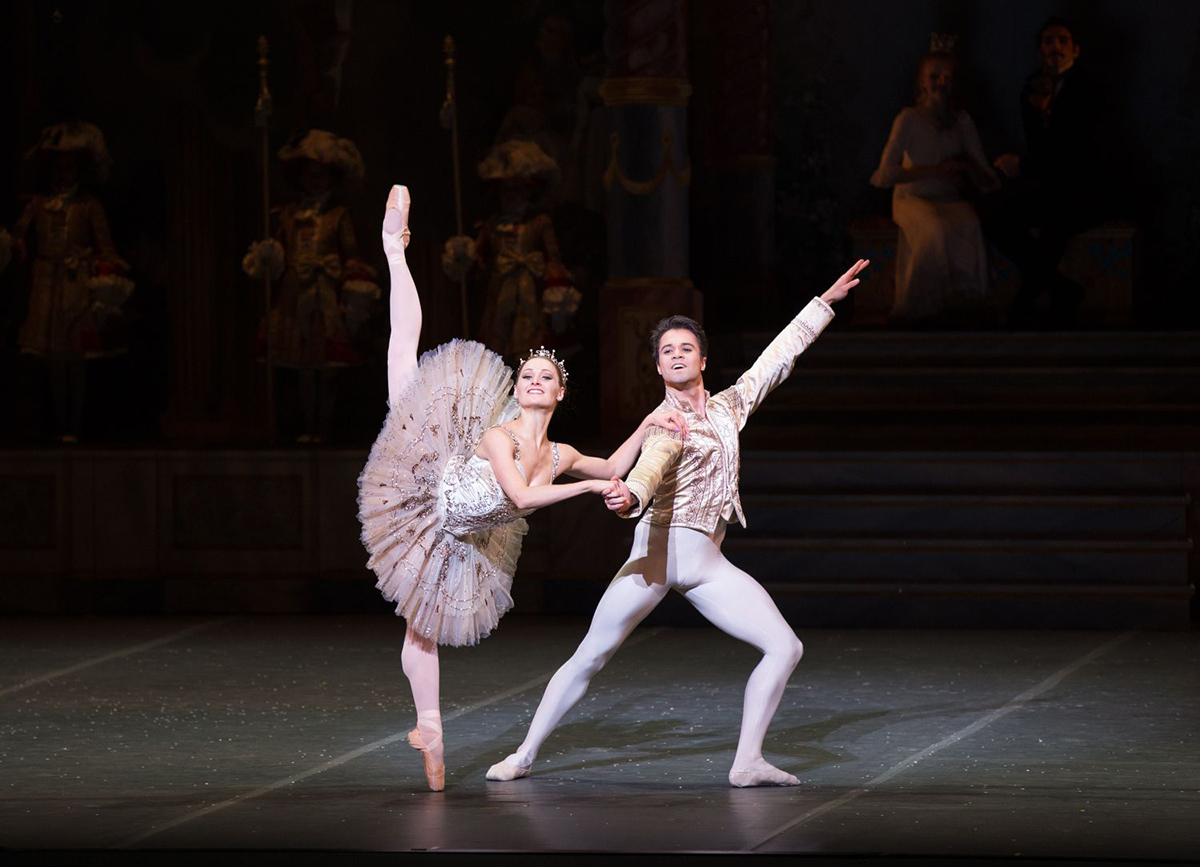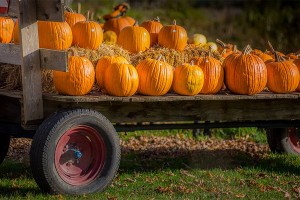Meet the Sugar Plum Fairies of Boston

Ashley Ellis plays the Sugar Plum Fairy in Boston Ballet’s The Nutcracker. / photo by Rosalie O’Connor, courtesy of Boston Ballet
—Boston Ballet’s The Nutcracker—
Ashley Ellis / “Sugar Plum Fairy”
Why should people come see your version of The Nutcracker?
It’s a very classic and classy version. The sets and costumes designed by Robert Perdziola are just stunning. I find it to be much more enchanting—it’s what Clara’s adventure and dream would really be like, as she travels through snow-covered woods on a sleigh and flies through the clouds to reach the Land of Sweets. And that’s not to mention all of the wonderful dancing that you’ll see. It’s really not to be missed!
Describe your pre-show routine for us.
Before I start getting ready, I’ll do a shoe check. I’ll make sure the ribbons are on the ones that I may wear that night and are the right color to match my tights. I’ll go to the stage level to try them on again, trying some of the choreography. Then I’ll make a final decision for which shoes will be my first, second—and sometimes third—choices, also which pair I’ll wear for the opening and another pair for the pas de deux. I can never have just one option—I’d be too nervous, thinking, “What if they die or something happens to them?”
I’ll have some coffee and then begin my makeup and hair. I like to be ready before the show starts, even though I won’t make an appearance until the opening of the second act. When the show is about to begin, I’ll go backstage to stretch and then do a good barre to get warmed up. Toward the middle of the “Snow” scene I’ll go up and put my tutu on. Then, it’s shoes on and to the stage to try a few steps while the curtain is down for intermission. From there, it’s up to my seat in the Kingdom of the Sweets and then—well, you know the story!
What do you like to do around Boston outside of dancing?
When I’m not in the theater being the Sugar Plum or any other role, I like to be home with my husband and our two big, cuddly Bullmastiffs. Together, we love to walk around Boston’s beautiful parks—we’re actually very lucky to live right across from the Arnold Arboretum. When I have more time off, I love to travel to new places and visit my family, whom I never get to see enough of.
***
—Jose Mateo Ballet Theatre’s The Nutcracker—
Angie DeWolf / “Sugar Plum Fairy”
Why should people come see your version of The Nutcracker?
It’s very different and there’s a lot of dancing. While some versions have a lot of acting, which ours does as well, Jose Mateo’s choreography is very thorough in regards to the actual dancing. The show opens with Dream Fairies and then follows with Drosselmeyer in his workshop, with the female and male dolls dancing a pas de deux. They then later show up jumping out of a box in the party scene for very difficult solos. In the second act, you’ll see a lot of pas de deux with some female duets and trios. Every female dancer in this production dances on pointe—even the young Clara—and the Snow Queen dances with four Snow Princes, which is very different from other versions.
Describe your pre-show routine for us.
My pre-show routine usually has a lot to do with my pointe shoes, especially when dancing the role of the Sugar Plum Fairy. I need something very specific because of all the partnering and the fouetté turns at the end. With that aside, I try to get myself as mentally prepared as I can while warming up and practicing things I feel I need to go over. In terms of rituals, I always wear a cross until I’m about to enter the stage. It’s very personal, and some may definitely say it’s a ritual. I also tend to wear the same thing for every warmup class—part of this attire is a special T-shirt given to me by my father. It’s just something I’ve always worn before a show.
What do you like to do around Boston outside of dancing?
I like to hang out with friends and be as social as I can when outside of work. I like to go to the beach in the summer and travel when I can, even if it’s just for a short weekend trip.
***
—Tony Williams Dance Center’s Urban Nutcracker—
Kate Penner / “Sugar Plum”
Why should people come see your version of The Nutcracker?
Urban Nutcracker has the ability to resonate with our audience in a way that a more traditional version can’t. Life today is a far cry from that of the 19th century, and while traditional versions of this ballet are beautiful, there’s something very special about seeing familiar characters on stage. Our Clarice [Clara] looks and behaves like someone you know. Same with our Sugar Plum. The list goes on! The world we construct on stage is, of course, part fantasy, but it’s also inspired by everyday life, which seeks to make a deeper emotional connection with our audience. Life in this city is diverse and exciting—your Nutcracker should be, too!
Describe your pre-show routine for us.
On show days, I try to get moving as early as possible to get my blood flowing. I wish I could say that I go to the gym to maintain my pristine physical instrument, but I usually head to my neighborhood coffee shop while lip synching Michael Jackson full-out down the middle of the street. I try to distract myself for a while by reading books (I love nonfiction), writing lesson plans (I teach math), or watching figure skating online (my favorite sport). Once it’s time to get ready, I start with a hot shower and some stretching. While I do my hair, invisible Oprah sits on the edge of the bathtub, and I talk to her about things I’ve been struggling with in rehearsal and my goals for that evening’s show.
I check my casting, but pack all of the clothes and shoes for every role I do, since things sometimes change at the last minute. On the way to the theater, pop music gives way to show music—for us, that’s Tchaikovsky and Duke Ellington. Once I get to the theater, I warm up in earnest with more intense stretching and class with everyone in the cast. At this point, we all sort of succumb to our inner demons and get superstitious and weird, so at T minus one hour, you can probably find me doing pirouettes again and again on the same part of the stage trying to suss out which shoes will be the best choice for me that evening. If things go well, I take it as a good omen. If things go poorly, I tell myself superstitions are meaningless anyway. Makeup goes on, hairpiece goes in, and I’m ready to go—or at least as ready as I’m going to be!
What do you like to do around Boston outside of dancing?
I love food, and I have many friends in the restaurant industry from my years working in it. Someone I know is always opening, mixing, cooking, or serving something new, and I love heading out on the town to see what they’re up to. I like to go ice skating, and I enjoy window shopping on Newbury Street. I can spend at least half an hour at MakerBot watching 3-D printers making tiny dinosaurs. I just started to learn to cook, so on an average night, you can find me at home or at a friend’s house with a Blue Apron meal, being highly supervised near open flame.
***
—The Slutcracker—
Vanessa White / “Sugar Dish Fairy”
Why should people come see your version of The Nutcracker?
The Slutcracker is a fun alternative to a traditional Nutcracker for a number of reasons. We use the original Tchaikovsky, which we had recorded in the Czech Republic for our show by the Brno Philharmonie, conducted by Mikel Toms, so if you love the music, we’ve got that.
The Slutcracker takes its framework from The Nutcracker, but changes it into a story for and by adults—in a season seemingly built exclusively for children—and incorporates several genres of dance, including ballet, jazz, burlesque, hoop dance, pole dance, belly dance, and more. The Slutcracker also sees both a truly diverse cast and audience. Everyone is welcome.
The Slutcracker also welcomes revelry. Being at The Slutcracker is more like being at a rock show than being at a ballet. The energy in this house is high, and the ticket prices are low.
Describe your pre-show routine for us.
As both a performer and director of The Slutcracker, my pre-show routine involves a lot. I usually arrive at the theater three to four hours before curtain. I’ll check in with the cast and crew, check and place my costumes and props, rehearse any scenes that need it, then lead a warmup. I usually try to find a quiet space for a few minutes to focus my energy away from directing and into performing. Then I hit up catering: I try to eat as little food with as many nutrients and calories as possible, so I’ll have the energy, but not the stomach cramps on stage. (The big dinner comes after the show.) Then, I work on my hair and makeup with the help of our in-house stylists, help with last-minute costume repairs, and, honestly, have a lot of laughs backstage. Before the curtain goes up, I gather the cast on stage for a little pep talk time, and we do some of our own custom breathing and bonding exercises. During the show, I watch as much as I can from a TV monitor so that I can be prepared with notes for cast and crew for when we do it all again the next day.
What do you like to do around Boston outside of dancing?
I don’t have much of a social life outside of dancing and directing, but I love going to other live shows. I love to catch local live music, dance, theater, stand-up, lectures, etc. Boston has a rich arts community, much of which flies under the radar of the general public. I like to support other artists and help grow our community into a destination city for the arts. Also, I love the beach.
Interviews have been edited and condensed.
***
Check out the productions for yourself:
Boston Ballet’s The Nutcracker, $35+, through December 31 at the Boston Opera House, 539 Washington St., Boston, bostonballet.org.
Jose Mateo Ballet Theatre’s The Nutcracker, $20+, through December 6 at the Cutler Majestic Theatre, 219 Tremont St., Boston, December 11-20 at the Strand Theatre, 543 Columbia Rd., Dorchester, ballettheatre.org.
Urban Nutcracker, $25+, December 11-27, Back Bay Events Center, 180 Berkeley St., Boston, urbannutcracker.com.
The Slutcracker, $27, December 4-31, Somerville Theatre, 55 Davis Square, Somerville, theslutcracker.com.


